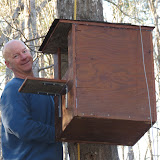I've been doing home automation since the early 80s. I started with an X10 (back when they were called BSR). Back in those early days, the only neat thing I did was turn on lights inside the house (about 4 lamps) when the garage door opened. My Ex actually thanked me for doing that, and it worked well. A few years later, I added controls to close the garage door at 11pm each night (very handy). I followed that with turning the water heater on and off as needed. My water heater is on for less than 30 minutes a day. By doing that, I estimate that I have saved $20 a month
for 25 years. That's at least $6000
!
About 4 years ago, I bought a
Vera. Then a couple years ago a, Vera3. Over the life of Vera, I've purchased 3 z-wave light switches, a couple appliance modules, and a of couple security modules. Vera was powerful, and you could program it. It would let you control lights and appliances (any z-wave device) using your smartphone - sort of. If I was at home on my local network, it worked well enough, but if I was away from home, I had to go to a web page to control devices. It worked, but it was not ready for prime time. Vera showed way too much of the complexities, and I found it difficult to use (but it could do almost anything, and if it didn't, you could write your own code).
Earlier this month, I bought an Arduino WiFi development board from
Spark.io, and that lead me to the
SmartThings Maker Kit that includes an Arduino shield. I have watched/listened to a couple of YouTube videos on the "Internet of Things" (IoT) which SmartThings is an implementer of. SmarterThings supports z-wave, ZigBee, and WiFi (such as
Hue LED Lights by Phillips). Vera does not support ZigBee, and since I have my eye on a
GE GeoSpring Hybrid Water Heater which has an optional Zigbee controller, I decided to get the SmartThings Maker Kit. The kit includes a hub that will allow me to control my existing z-wave devices and experiment with my Arduino kit.
I liked the SmartThings from the second I opened the box. It was a snap to unbind my z-wave devices from Vera and pair them with the SmartThings hub. Since Maryann mentioned that Joey needed a key for the house, I decided it was a perfect time to get a z-wave door lock. Johnny and I installed the
Schlage Keypad Lock With Lever and paired it to the SmartThing hub in less that 30 minutes. It was so easy to program, that Johnny, who is 10, was able to do it on his own! Now, the boys can use the keypad and their own personal number to unlock the door if necessary.
We're also implementing the SmartThings Presence Sensor. I'm home when Joey gets home each day, but Maryann is in the van picking up Johnny. Now, instead of asking me, SmartThings will notify her on her cell phone when Joey and his bookbag enter the house.
After installing the lock and programming it, I can say that home automation has came a long way since 1982 and the days of the X10.








